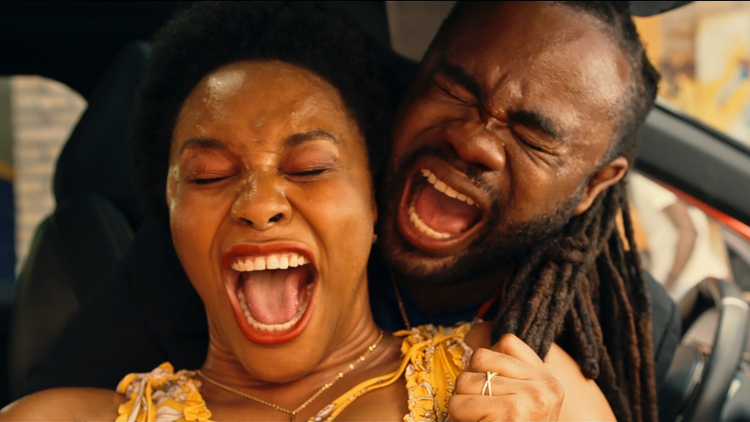Director, co-writer, producer and co-editor Bruno Mourral uses Adobe Premiere Pro to shape Sundance film “Kidnapping Inc.”

Image Source: Sundance Film Festival.
“Kidnapping Inc.” takes the stage at Sundance Film Festival this year, taking audiences on a thrilling journey through the streets of Port-au-Prince. Directed, co-written, produced and co-edited by Bruno Mourral, this darkly humorous yet deadly serious political thriller tells the story of two hapless kidnappers who find themselves stumbling in the middle of a political conspiracy.
Mourral used Adobe Premiere Pro to edit the film, collaborating with his team based in separate locations. “I think Premiere Pro is very intuitive and powerful,” he shared. His reason for choosing Premiere Pro primarily stemmed from its capability to edit directly with 4K raw footage — a feature he believed was unique to Premiere Pro, making it an ideal fit for his workflow.
We sat down with Bruno to hear more about his editing workflow. Read on below for more insights into the making of the film.
How and where did you first learn to edit?
I started editing at film school, EICAR (The International Film & Television School) in Paris.
How do you begin a project/set up your workspace?
I like to create a project per scene. It makes it easier to navigate, and it’s lighter to run.
On the upper side of my screen:
- On the left, I have different folders structured per shot, music, and other elements
- In the middle and right, I have my two screens for preview
- At the bottom, the entire timeline takes half of the screen. I also like to blow up my tracks.
Tell us about a favorite scene or moment from this project and why it stands out to you.
One of my favorite scenes in “Kidnapping Inc.” is the shoot-out. Sometimes, I like to edit without sound to see how the image will work by itself. I’ve been editing that action scene for months and thought everything was running smoothly. However, when Arthur Tarnowski, my co-editor, jumped into the project with fresh eyes, he gave me some tips to make it tighter. I was a bit hesitant at first, but I’m glad I followed his advice. The image became much more dynamic, and when we added the sound, everything came out so well together.
What were some specific post-production challenges you faced that were unique to your project? How did you go about solving them?
I started editing with 4K raw footage. At this time, I was working on a Mac Pro 2013, which was going slower as the project was growing. But when I upgraded to the new MacBook Pro M1, it completely changed my workflow. I was able to edit the entire project with my raw 4K footage on Premiere Pro. Everyone thought I was crazy, but Premiere Pro is very powerful — if you match it with a good machine, it’s totally possible." to "Everyone thought I was crazy, but Premiere Pro is very powerful — if you match it with a good machine, it’s totally possible. Working directly in 4K was great for this project, making the online much simpler for the color grading.
What Adobe tools did you use on this project and why did you originally choose them? Were there any other third party tools that helped enhance your workflow?
Stabilization is one of the great tools that helped me during this project. It works very well with unsteady shots. I also use a lot of reframing and computer-generated zoom to build up tension.
Do you use Frame.io as part of your workflow? If so, how do you use it?
We only used frame.io at the very end of the project to send our Master for the DCP. I regret not using frame.io earlier to share my thousand notes and more during the post production process.
If you could share one tip about Premiere Pro, what would it be?
You can work in 4K raw! For me, this is one of the things that makes Premiere Pro stand out.
Who is your creative inspiration and why?
I have a bunch of creative inspiration starting from Scorsese, Tarantino, The Wachowskis, Christopher Nolan, Guy Ritchie, Charlie Kaufman, Alain Chabat, Les Inconnus, Michel Gondry, Hans Zimmer, Johan Johannsson, and many more… It’s a big mix.
What’s the toughest thing you’ve had to face in your career and how did you overcome it? What advice do you have for aspiring filmmakers or content creators?
We had to go through many problems during the shoot of “Kidnapping Inc.” The kidnapping of our crew, the assassination of the president, COVID-19, financial issues, political protests, and several lockdowns of the country. Despite all this, my crew stood up behind me. They saw my motivation to finish the film and gave me everything. Ultimately, if you really want something and can convince your team, they will follow you. If you start a movie, you must finish it. This is the number one rule for directors.
What’s your favorite thing about your workspace and why?
Editing is mind-intensive and consuming work. It takes a lot of time and patience to edit. So, investing and designing in a suitable workspace where you feel comfortable is essential. My workspace is at home and very calm when my five kids are not around! That’s why sometimes I have to work late at night!